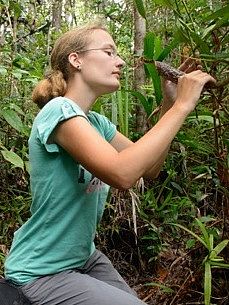Applied Zoology and Nature Conservation, University of Greifswald
Costs and benefits in a bat-pitcher plant mutualism

In mutualisms species benefit by interacting with each other but permanently act selfishly. Thus, the involved partners must balance gaining the maximal benefit while accepting a certain amount of costs from the interaction. However, for many supposed mutualisms the partners’ costs and benefits have never been evaluated. Using the interaction between an insectivorous bat species (Kerivoula hardwickii) and carnivorous pitcher plants (genus Nepenthes) as a model system, we conducted a rigorous cost-benefit analysis of the plants and their mammal partners. Regarding the bats, we found that N. hemsleyana offers high quality roosts with a favourable microclimate and low parasite infestation risk. The bats did not have to invest much time and energy to find N. hemsleyana plants, which continuously provide at least one intact pitcher so that bats can return to the same plants over long time periods. Regarding the plants, our results suggest that N. hemsleyana has outsourced arthropod capture and digestion to its bat partner while arthropod attraction is strongly reduced. N. hemsleyana plants gain between 34% and 95% of their nitrogen from bat faeces, which significantly improves their growth, photosynthesis and survival. Pitchers occupied by bats do not differ in their lifespan from unoccupied ones as bats do not injure the plants’ tissue. In conclusion, both the bats and N. hemsleyana seem to gain higher benefits than costs by interacting with each other. As a consequence, the interaction can be classified as facultative mutualism with stronger dependence of the plant partner.
comments powered by Disqus